Brewing in Memoriam

I love homebrewing. I love diving into the details of the recipe, geeking out on equipment, connecting with a rich and timeless community of beer lovers, and understanding just what RDWHAHB means. During the last fifteen years, I’ve learned that brewing is more than just making beer. It’s about connecting with fellow brewers and sharing the experience of beer with friends and family, celebrating birthday parties, weddings, holidays, and other special events. There’s something quite special about showing up to a neighbor’s picnic with a handful of fresh German Pils. And nothing beats a yearly tradition of brewing a strong beer with a couple of buddies for the winter months. For me, these joyous experiences are the essence of home-brewing. Otherwise, it’s just beer.
While brewing can be meaningful for celebrations, it also can be a therapeutic distraction during difficult times. During uncertain times, normalcy helps us stay grounded and sort through chaos. No matter what’s happening in the world around us, we can still escape into our brew space early Saturday morning. There’s a comfort in fretting over pH and starch conversion when the world around us is heavy. After these past years, I’m sure many of us can appreciate the relief of the simple and the familiar.
On August 8, 2020, my youngest brother, Jim’s, 31st birthday, I therapy-brewed a monster English-style barleywine for him. This was a “hide it in the back of the basement to enjoy for the next twenty years” kind of barleywine, and it had to be perfect. I had reformulated the recipe probably a hundred times in anticipation of the day, but after all was said and done, I honestly don’t remember much of the brewing process except the familiar aromas of mashed grain and boiling hops, and the monotone roar of the jet engine I call a propane burner. My mind was elsewhere.
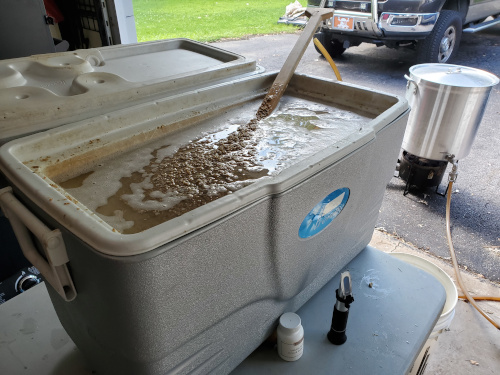
I brewed in memory of my “baby” brother on that day because we had lost him on May 18, 2020. Jim was serving in the United States Air Force, piloting MQ-9 Reapers at Creech Air Force Base, outside Las Vegas, Nevada. As with too many remotely piloted aircraft (RPA) pilots, Jim found himself struggling with his work. He longed to be in the sky with his beloved C-130J again.
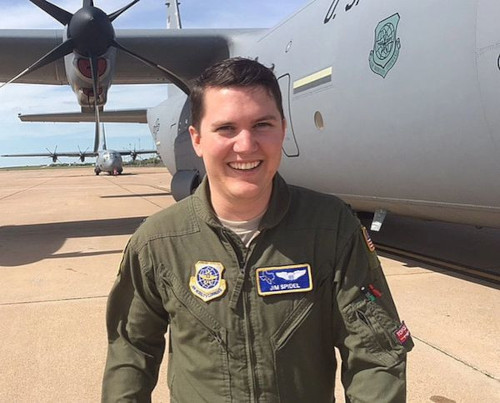
An Air Force Academy graduate and combat-experienced pilot, my brother, like many others in his C-130J squadron, was reassigned to flying RPAs without being trained to confront the specific psychological effects of these drone missions. This type of combat requires an upfront seat to the horrific aftermath of a missile strike, all displayed on a video screen. Along with the drudgery of surveillance and sleep deprivation of continually rotating shifts, flying drones takes a tremendous psychological toll on service members. Jim watched as his co-pilots’ mental health deteriorated to the point where they attempted or succeeded in taking their own lives. He suffered silently with post-traumatic stress (PTS) and situational depression because seeking out mental healthcare from the USAF can come with career-ending consequences, as was the case for Jim’s best friend. Jim tried to suppress the signs of his deteriorating mental health with the hope of leaving the drone program and flying the C-130J within the year, but before that chance came, Jim lost his battle with PTS and depression at just thirty years of age.
In May 2020, my world shifted from lockdown Zoom meetings and homeschooling to flying to Jim’s home to begin working through the shock with my family. It was hard and unsettling to be there without him, but there was one moment of peace when I found two familiar friends tucked away in his refrigerator – hops and yeast. When I saw Jim a few months earlier, he told me how he had picked up the ingredients to get back into home-brewing but couldn’t find the time to do it because of his demanding work schedule. Jim wasn’t a hardcore brewer, but he brewed 1-gallon BIAB batches with friends to relax and escape the real world for a bit. As we sorted through his house, I found the few pounds of grains he had stashed away for a happier day. It was a gift – something familiar amidst the chaos.
The chaos of the following days and weeks turned to months of disbelieving grief. I tried to piece together the puzzle of what really happened that fateful night, searching for answers to why someone with no previous history of mental illness was now gone. As I worked through the grieving process, talking with counselors and finding support with family and friends, I realized one thing I was seeking was a personal connection with my late brother.
There are four kids spanning twelve years in my family; I am the eldest and Jim the youngest. I was practically out of the house when Jim started elementary school, so I missed much of his childhood. I was immersed in grad school when he was in middle and high school, and I started my family when he was in college. It’s funny that as different as we four siblings are, and despite growing up fairly independent of one another, we each have similar personalities. We all have a refined taste in very dark humor, satire, and sarcasm, but poop jokes are always funny as well. Although no one in our family of origin drank or smoked, in each of our separate travels, we discovered the beauty of bourbon and the soothing aromatics of pipe tobacco. The four of us are all “doers” – we would rather do than watch, taking up hobbies is our hobby, and exploring life is the adventure.
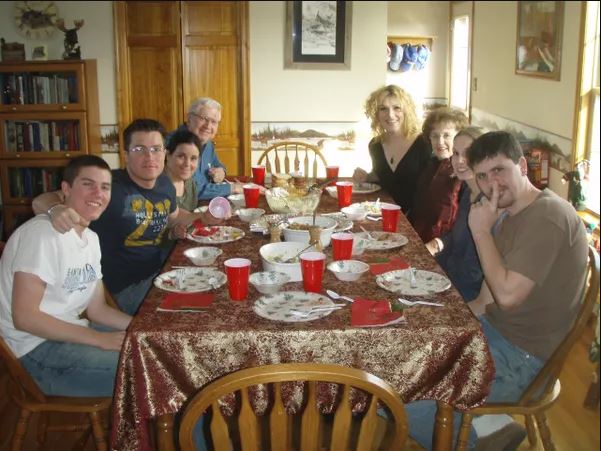
Because of these similarities, finding ways to remember Jim wasn’t a problem for me. I could connect with him when hiking, fishing, hunting, smoking his pipe, or wearing his jacket, but I wanted to find something deeper, a unique shared experience between him and me. After a few weeks, it hit me – brewing was the bond I was looking for. Though we never brewed together, we were always connected through homebrewing.
The year following a death is a year of firsts. I knew Jim’s first birthday without him was going to be tough, but as the day approached, I found comfort in our shared hobby. While it was a very hard day, brewing helped tether me. It kept me from retreating too deeply into dark places by giving me a purpose and allowing me to stay focused on something tangible. That day, I celebrated him by making the beer he never got around to making.
In Jim’s house, I found 1 pound of Rahr Pale Ale malt, 3 pounds of Rahr Red Wheat malt, 1 pound of Briess Carmel 10L malt, an ounce each of Sorachi Ace and US Saaz, and a packet of Muton’s dry ale yeast. I asked myself, “what in the world can I make with these ingredients?” I wanted his ingredients to be the focus and not just buried in a stout, but as is the malt bill was not going to work out so well. Plus, I didn’t know the condition of the hops. While vacuum-sealed, they had been stored in the fridge for an unknown time. What I did know was that I wanted to make something that I could savor for years to come and make it personal for Jim. I think it was the Mutton’s yeast that inspired me to make an English-style barleywine. Like me, Jim gravitated to big, malty beers, so this was a perfect fit.
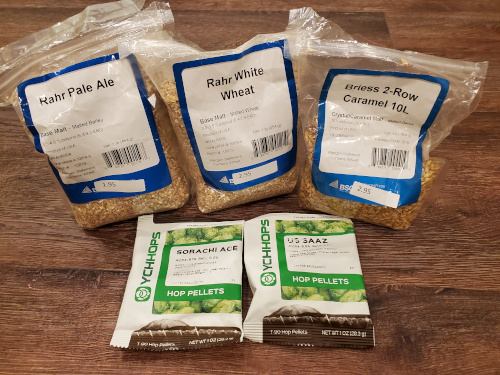
I’ve been making a Christmas barleywine every year for about a decade, and I used the same techniques for this beer. I perform a partigyle mash to get the richest sugars in the first runnings with a long boil to develop deep caramel and dark fruity flavors. To be true to his ingredients, I added more Rahr Pale ale malt to bump up the gravity. The hops in an English-style barleywine are there to balance sweetness, so Sorachi Ace and US Saaz worked for a bittering addition. I was a little short on hops, but I lucked out and grabbed the last ounce of Sorachi Ace in the homebrew shop just before brewday. Muton’s ale yeast isn’t quite world-renown for making fine beer, but I think that’s more to do with the product than the yeast strain. Since the tiny packet of unknown age and origin would be problematic in such a huge beer, I grew up a starter with a tiny amount of yeast and saved the rest of the packet to pitch alongside the starter.
To add a personal element to this beer, I decided to age it with oak and bourbon as a nod to Jim’s love of bourbon. After racking the beer to secondary, I added a medium plus-toasted American white oak spiral that was soaked in bourbon for a few weeks along with excess bourbon (maybe a few tablespoons). After four months of aging at cellar temperature, I transferred it to a keg, force carbonated it, and bottled.
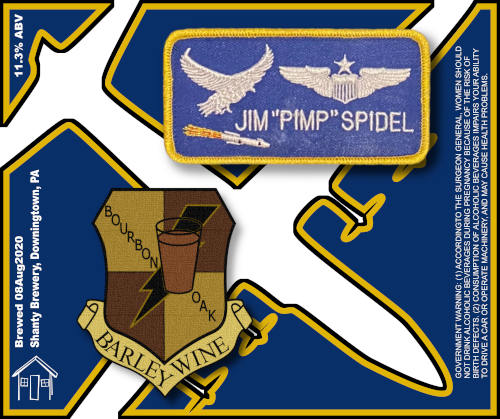
The label design was surprisingly therapeutic too. I’m not one for art therapy but capturing the spirit of my brother and his loss by designing a label in his honor helped me to sort through a mountain of emotions. I outlined a picture of the C-130J that flew overhead at his memorial service, flown to Pennsylvania by a crew from Dyess Air Force Base where Jim had previously been stationed. I crafted the oaked barleywine patch based on his most recent squadron’s patch. Finally, I included his name patch with his call sign, “PIMP”, which subtly speaks volumes to who he was.
One thing none of us could quite understand was his seemingly strange call sign. While highly adventurous, Jim was introspective, practical, and humble — not the type of personality that you would call a “pimp”. His closest friends didn’t even know the origin of this call sign until we were all sitting at my parent’s dining room table after Jim’s funeral. One of his buddies disclosed a story we had never heard before, that PIMP was an acronym for “Poop In My Pants.” Apparently, pilots simply can’t take a break while flying a mission, so sometimes things happen… This perfectly described Jim — poop jokes are always funny, but the joke was much funnier by him not telling everyone.
May 18th, 2021 was the anniversary of Jim’s death. I cracked open the first bottle. The beautiful amber-copper beer poured crystal clear into the New Belgium goblet I picked up on the brewery when I was visiting Jim while he was attending the USAFA in Colorado Springs. The sweet smell of dark caramel, vanilla, cherry, with a bit of oak and bourbon wafted from the glass. I savored every sip that connected me to Jim. I was reminded of the similarities and connection only brothers share. I could see his eyes light up as he tasted the complex oaky, malty sweetness with hints of bourbon, earth, and leather. So good. I remembered us sitting around the table at my parents a few Christmases ago playing games and enjoying a vertical tasting of a few of my annual barleywines. Yes, Jim would have loved this beer.
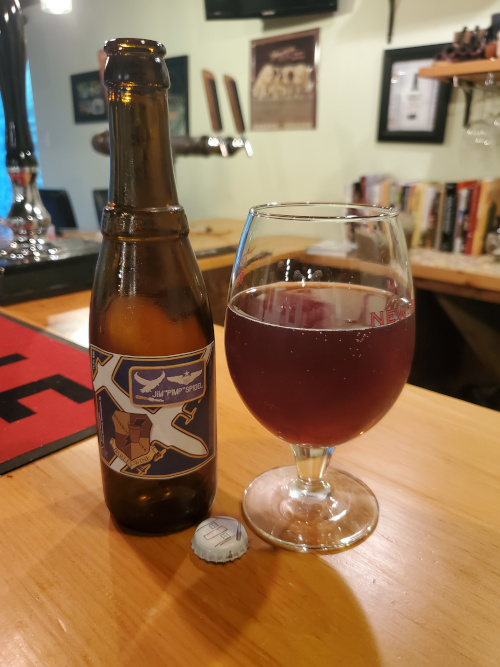
I will never have a chance to brew with my brother in life, but I will continue to brew with him after his death. Our shared love of brewing is a gift I will always treasure, and this barleywine will connect us even long after the last bottle is empty.
PIMP Barleywine
Batch volume: 5.5 gallons
Original gravity: 1.119
Final gravity: 1.033
Color: 6 SRM
Bitterness: 58 IBU
Alcohol: 11.3%
Malts:
26 lbs Rahr Pale Ale
3 lb Rahr White Wheat
1 lb Briess Caramel Malt 10L
Hops:
1 oz Sorachi Ace, 9.1% a.a. @ 60 min
1 oz Sorachi Ace, 13.5% a.a. @ 60 min
1 oz US Saaz, 8.5% a.a. @ 60 min
Yeast:
Muntons Ale Dry Yeast
Additional ingredients:
Medium plus American white oak spiral infused with Jim Beam for three weeks
Brewing notes:
Mash grains for one hour at 152°F at pH 5.4 with a mash thickness of 1.4 qt/lb. Vorlauf and collect just the first runnings (~7.25 gallons). Boil for 2 hours, then add hops and continue boil for an addition hour. Add whirlfloc with 15 minutes remaining in the boil. Cool to 66°F, oxygenate, and pitch a health yeast starter (~365 billion cells). After primary fermentation is completed (~ 1 month), transfer to secondary fermenter and add bourbon infused oak spiral plus a few ounces of the excess bourbon to taste for 4 months. Carbonate to 2 volumes CO2.